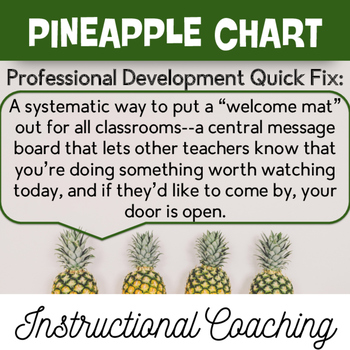Pineapple Charts: A Creative Approach to Professional Development
There are a multitude of ways that training can be delivered to education staff, both formally and informally. It is important to acknowledge that the education system is changing (e.g., new pedagogies and types of technology, while also adjusting to staffing concerns, etc.) and we must adapt to these changes in order to maintain innovative as lifelong learners. A creative approach to teacher training that I have read about and would be interested in trying is Pineapple Charts.
What is it?
Pineapple Charts provide an open invitation for other educators within your school setting to pop into your classroom and watch you facilitate a specific activity or lesson. The goal would be that other educators might learn something from watching and/or participating in your classroom that could be useful or integrated into their own classroom. Simply put, Pineapple Charts provide a space for “meaningful and affirming collaboration” for educators (Edutopia, Opening the Door to Professional Learning).

How does it work?
Let’s say you have a tried-and-true lesson that your students enjoy every time you use it. Or, you have designed a new lesson that has your heart and mind pumping with excitement to try. Or, you are going to use a teaching strategy or technology tool that you think other teachers might benefit from seeing in action. Really, any sort of lesson that you think other teacher’s might be interested in, you post that information on the school’s Pineapple Chart. A Pineapple Chart is a blank chart with each day of the week and each period of the school day that is posted in the staffroom (or anywhere teachers gather) or digitally (shared Google Doc) where teachers can fill in information about their lesson (TECA, Pineapple Charts: Learning from Your Peers).
For example, if I know that I am going to teach my students about coding on Spheros on Wednesday right after lunch, I will write that in the Pineapple Chart (e.g., Mr. Burton – Sphero Coding). If this is something that another teacher has been interested in learning more about or seeing in action, but hasn’t found a way of learning that works for them (e.g., online training), they can come attend my lesson at that time. Teachers can either use their planning time, or can rearrange their planning times with other colleagues in the building, to attend this valuable, yet informal professional development.
But, what’s with the pineapple?
Well, pineapples are a symbol of welcoming and hospitality, which fits well with the overall theme of the Pineapple Chart! This approach to teacher training is built on organic, staff-led collaborative learning. When a culture of open-doors and teamwork is fostered and embraced, the level of deep learning that can be achieved is unmatched.

How can this strategy be implemented successfully?
This strategy to teaching training only works if teachers are willing to open their classrooms up to their colleagues. That being said, there may be some things that have to be put in place in order for staff to buy-in. Adrian Cargal, an Instructional Coach and author at Edutopia, outlines 3 key components to successfully implement the Pineapple Chart:
(Edutopia, Opening the Door to Professional Learning).
- It’s a voluntary endeavor: Pushback will be inevitable if it’s a required task.
- The Pineapple Chart is accessible by all employees: A shared document via Google Slides or an equivalent is optimal.
- It’s a connected call to action that inspires others to join in on the fun: Highlight the positive things that you’ve observed in your classroom at every possible opportunity. This will encourage your colleagues to participate and will make the PD experience more collaborative.
Have you used Pineapple Charts in your school setting? What are some ways that staff buy-in could be fostered? What other uses could this strategy be used for? I’d love to hear your thoughts in the comments!